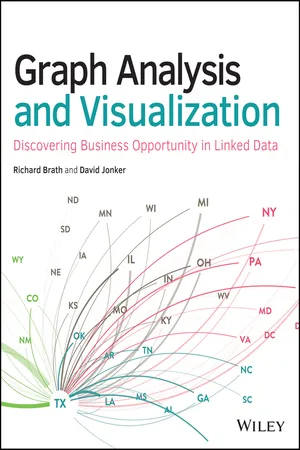
Graph Analysis and Visualization
Discovering Business Opportunity in Linked Data
- English
- ePUB (mobile friendly)
- Available on iOS & Android
Graph Analysis and Visualization
Discovering Business Opportunity in Linked Data
About this book
Wring more out of the data with a scientific approach to analysis
Graph Analysis and Visualization brings graph theory out of the lab and into the real world. Using sophisticated methods and tools that span analysis functions, this guide shows you how to exploit graph and network analytic techniques to enable the discovery of new business insights and opportunities. Published in full color, the book describes the process of creating powerful visualizations using a rich and engaging set of examples from sports, finance, marketing, security, social media, and more. You will find practical guidance toward pattern identification and using various data sources, including Big Data, plus clear instruction on the use of software and programming. The companion website offers data sets, full code examples in Python, and links to all the tools covered in the book.
Science has already reaped the benefit of network and graph theory, which has powered breakthroughs in physics, economics, genetics, and more. This book brings those proven techniques into the world of business, finance, strategy, and design, helping extract more information from data and better communicate the results to decision-makers.
- Study graphical examples of networks using clear and insightful visualizations
- Analyze specifically-curated, easy-to-use data sets from various industries
- Learn the software tools and programming languages that extract insights from data
- Code examples using the popular Python programming language
There is a tremendous body of scientific work on network and graph theory, but very little of it directly applies to analyst functions outside of the core sciences – until now. Written for those seeking empirically based, systematic analysis methods and powerful tools that apply outside the lab, Graph Analysis and Visualization is a thorough, authoritative resource.
Frequently asked questions
- Essential is ideal for learners and professionals who enjoy exploring a wide range of subjects. Access the Essential Library with 800,000+ trusted titles and best-sellers across business, personal growth, and the humanities. Includes unlimited reading time and Standard Read Aloud voice.
- Complete: Perfect for advanced learners and researchers needing full, unrestricted access. Unlock 1.4M+ books across hundreds of subjects, including academic and specialized titles. The Complete Plan also includes advanced features like Premium Read Aloud and Research Assistant.
Please note we cannot support devices running on iOS 13 and Android 7 or earlier. Learn more about using the app.
Information
Part 1
Overview
| Topic | Description | |
| Why Graphs? (Chapter 1) |  | What are graphs, and why are they useful to a business analyst? Chapter 1, “Why Graphs?,” introduces the concept of graphs, and defines several key terms used in this book. Select historical and modern anecdotes recount applications of graph analysis and visualization in business, documenting a steady rise to prominence spurred on by today’s challenges of vast and complex data. Real-world cases attest to the value of graphs. |
| A Graph for Every Problem (Chapter 2) |  | Chapter 2, “A Graph for Every Problem,” provides a systematic overview of the wide variety of graph types and the kinds of problems they are useful for solving. The discussion begins with an example contrasting how relationships revealed in other ways can also be expressed using nodes and links. Subsequent topics describe graph techniques for gaining business insights involving hierarchies, communities, flows, and spatial networks. References are included to further detail in subsequent chapters. |
Chapter 1
Why Graphs?
Visualization in Business
Table of contents
- Cover
- Titlepage
- Copyright
- Dedication
- About the Authors
- About the Technical Editors
- Introduction
- Part 1: Overview
- Part 2: Process and Tools
- Part 3: Visual Analysis of Graphs
- Part 4: Advanced Techniques
- Glossary
- End-User License Agreement